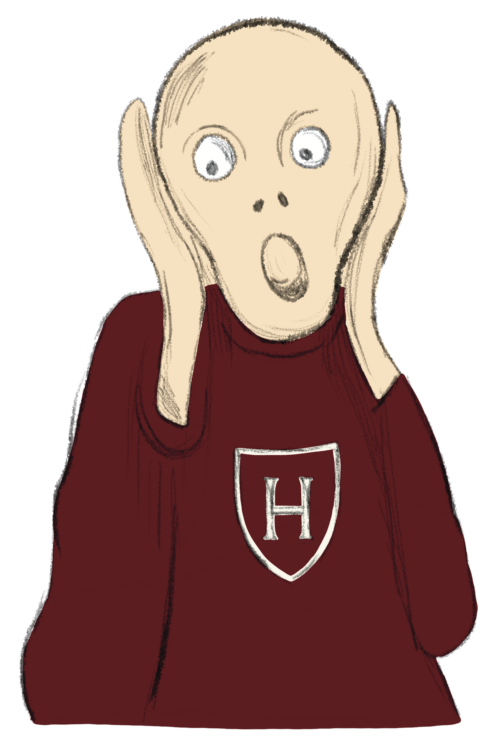On a brisk Friday afternoon, after exiting Harvard Yard, we had the opportunity to see the Harvard Art Museums’ new exhibit, “Edvard Munch: Technically Speaking,” on its opening day. The experience felt like more than a casual weekend stroll through a gallery; it was a journey through a man’s fractured and perhaps disturbed psyche, stretched out in brushstrokes and anguish.
Walking into the exhibit, we stepped into Munch’s mind. Though absent in body, Munch was present in spirit. We engaged with the more than 70 mixed-media print and painted works from his lifelong artistic engagement with the uncanny. Curated in large part thanks to a gift from the collection of Philip A. and Lynn G. Straus, the works were hung alongside the original woodcuts and carved print blocks Munch used to reproduce his prints. It was apparent quickly that his most famous piece, “The Scream,” an iconic portrayal of pure, unfiltered panic, was not the only work by Munch that deserves attention.
A particularly eye-catching piece was the haunting silhouette of “Two Human Beings (The Lonely Ones).” The work, placed at the very center of one of the rooms, drew a crowd of onlookers, all craning their necks to catch a glimpse of isolation made manifest. Around them hung variations of painted woodblocks, etchings, and matrices of the same image born and reborn, each ghostly scene crafted by Munch’s fevered hand—no two prints were created exactly the same. The mood was palpable: silent, eerie, and magnetic, drawing in the souls who came to gaze into the abyss of Munch’s inner workings. With each piece, we stared into an adjacent reality.
Before the exhibit opened, however, the pieces underwent a restoration process that combined traditional conservation practices like varnish removal with more investigative technical examinations to uncover the methods behind Munch’s exceptional production. In an interview with the Harvard Independent, Kate Smith, Senior Conservator of Paintings and Head of Paintings Lab, Ellen Davis, Associate Paintings Conservator, and Abby Schleicher, Assistant Paper Conservator, spoke about their experience working with the extensive collection.
Many of the gifted works combine print and paint—Munch showed no restraint in blending various artistic techniques and working across mediums. For the conservators, this meant frequent communication between the print and paint teams and considerable technical analysis. This analysis involved procedures ranging from microscopic investigation to fiber identification to parse out Munch’s creative process.
The technical exams answered open questions not just about Munch’s techniques but also about the materials he used. According to Schleicher, thanks to scientific examination, they found that Munch “is using very contemporary materials…like very new pigments that are being developed during his lifetime, and papers that are being developed during his lifetime. So it’s like he’s very experimental, and I think that speaks to him as an artist.”
For Davis, the restoration process led to an entirely new viewing experience for Munch’s painting “Winter in Kragerø.”
“It’s a painting that’s always on view at the museums and everyone knew so well, or thought they knew so well, but after cleaning it just before the opening of the show, [we found that] it’s just almost a completely different painting than what we had gotten to know so well before,” she said. “The purples and the blues and the greens are just almost psychedelic, compared to the gray, snowy day that we were so familiar with.”
When we first viewed “Winter in Kragerø,” we were taken aback by the vibrance of the colors and how it completely changed our interpretation of the frosty scene. The pale white snow that blankets the picture looked practically eternal. The colors felt ghostly, with pale blues and whites composing a threshold of liminal space; yet everything in Munch’s created world was lucid.
The rest of the exhibit proved just as enlightening. Presenting multiple distinct iterations of various pieces, the exhibit called the meaning of “finality” into question—Munch was more an experimentalist than a perfectionist. Ten tangibly different versions of “Two Human Beings (The Lonely Ones)” were displayed next to the single fundamental wooden print block that birthed them. We gazed upon the depressed form of eleven duplicate figures, all “Melancholy.” Regardless of Munch’s iterative process, each piece stood as a complete work in its own right. There were no perfect “final” versions.
“Edvard Munch: Technically Speaking” is more than just a groundbreaking exhibition—it is a posthumous exploration and celebration of man’s mad brilliance, a window into the mind of a long-gone artist. The exhibit sheds light upon the process behind the paintings—Munch’s psyche laid bare for all to see as he experimented with complex print techniques.
Adding this exhibit to the HAM’s extensive history of high-quality exhibits has been an exciting new development for Smith. “We’re a Munch place now, which is cool…it’s an identity piece now for us,” she said. Expanding their Munch collection has allowed the HAM to provide insight into his iterative prints for many more people.
“I’m really so happy for us that we have that to offer people now,” said Smith.
The exhibit will remain on display March 7–July 27, in the Special Exhibitions Gallery on Level 3 of the Harvard Art Museums.
Mia Tavares ’27 (miatavares@college.harvard.edu) and August Hachmeister (augusthachmeister@g.harvard.edu) often visit the HAM.

